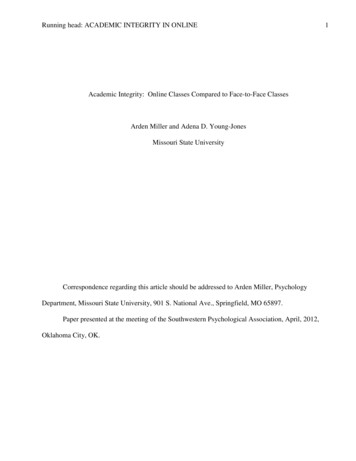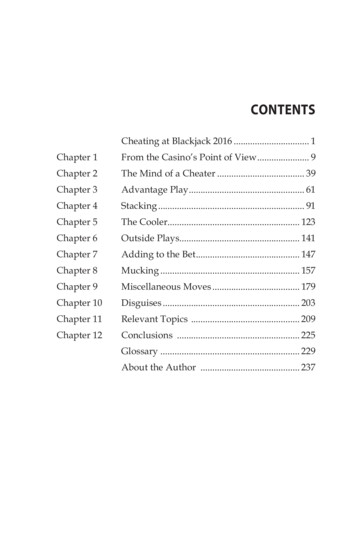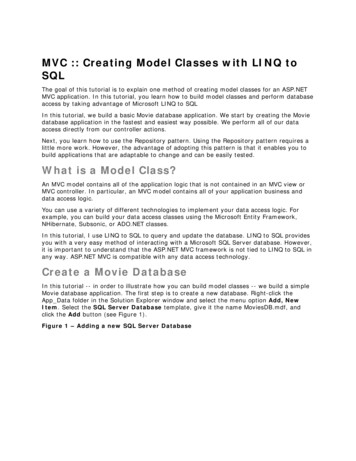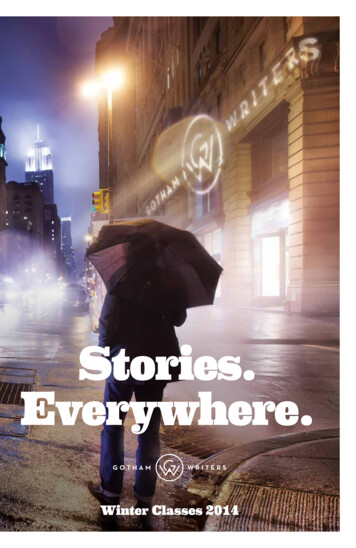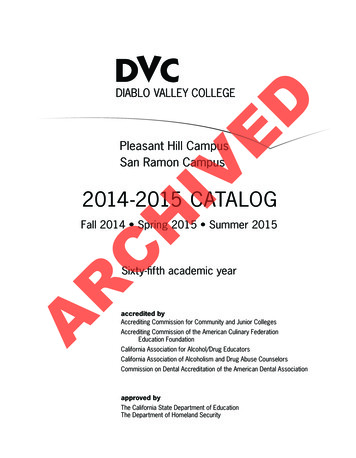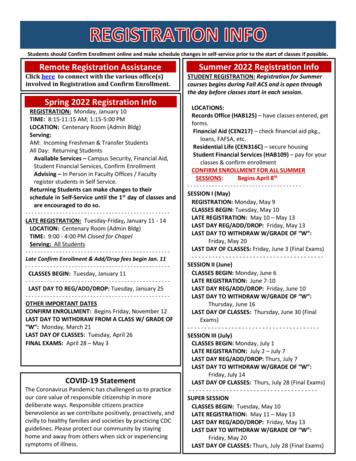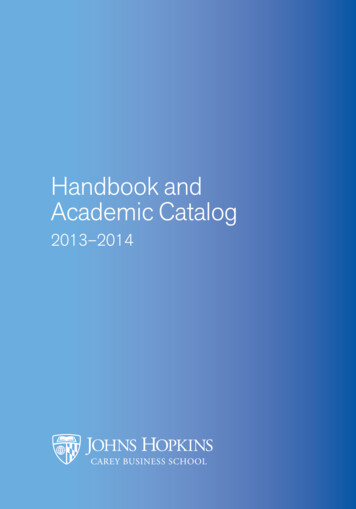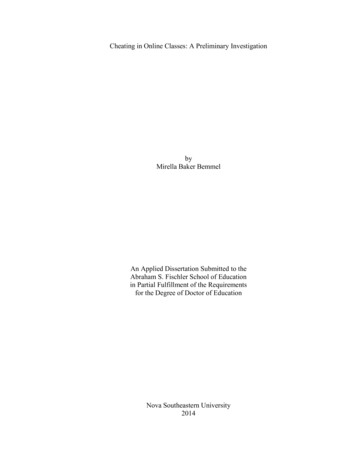
Transcription
Cheating in Online Classes: A Preliminary InvestigationbyMirella Baker BemmelAn Applied Dissertation Submitted to theAbraham S. Fischler School of Educationin Partial Fulfillment of the Requirementsfor the Degree of Doctor of EducationNova Southeastern University2014
Approval PageThis applied dissertation was submitted by Mirella Baker Bemmel under the direction ofthe persons listed below. It was submitted to the Abraham S. Fischler School ofEducation and approved in partial fulfillment of the requirements for the degree ofDoctor of Education at Nova Southeastern University.Gordon Doctorow, EdDCommittee ChairDateMichael Simonson, PhDCommittee MemberDateMary Ann Lowe, SLPDAssociate DeanDateii
Statement of Original WorkI declare the following:I have read the Code of Student Conduct and Academic Responsibility as described in theStudent Handbook of Nova Southeastern University. This applied dissertation representsmy original work, except where I have acknowledged the ideas, words, or material ofother authors.Where another author’s ideas have been presented in this applied dissertation, I haveacknowledged the author’s ideas by citing them in the required style.Where another author’s words have been presented in this applied dissertation, I haveacknowledged the author’s words by using appropriate quotation devices and citations inthe required style.I have obtained permission from the author or publisher—in accordance with the requiredguidelines—to include any copyrighted material (e.g., tables, figures, survey instruments,large portions of text) in this applied dissertation manuscript.Mirella Baker BemmelSignatureMirella Baker BemmelNameMay 12, 2014Dateiii
AcknowledgmentsThis memorable journey I was blessed with would not have been possible withoutthe enthusiasm and encouragement from my wonderful husband, Ahmed Baker and oursons Sharif and Tariq. I will be eternally grateful for their unconditional love andunwavering support. I would also like to thank my mother and siblings, who inspired mebeyond belief and catapulted me higher than I ever thought possible.My deepest appreciation goes out to my Dissertation Chair, Dr. GordonDoctorow. Our first meeting in Orlando three years ago was the beginning of a whirlwindof exploration guided by a strong commitment to scholarship, tremendously helpfulmeticulous feedback, insightful suggestions, and encouragement in the most kind andprofessional manner imaginable. While reaching the final destination is certainly icing onthe cake, the journey provided an experience of personal and intellectual growth, whichhas changed the course of my life forever.A word of thanks to those helped me conduct my research, especially the staff atthe institutions at the focus of this study, whose assistance I could always count on.Finally, I would like to thank my friends, family, and colleagues whose words ofencouragement helped me get through this process. Their loving and supportive inquiries,prayers and constant words of reassurance were never taken for granted.I dedicate this dissertation to my father, whose spirit was my guiding light. Hislife story inspired me to persevere with an insatiable hunger for intellectual growth andsteadfast determination.iv
AbstractCheating in Online Classes: A Preliminary Investigation, Mirella Baker Bemmel, 2014:Applied Dissertation, Nova Southeastern University, Abraham S. Fischler School ofEducation. ERIC Descriptors: Cheating, Online, Academic Integrity, CommunityCollege, SafeguardsThis applied dissertation was an inquiry into the phenomenon of cheating among studentswho take their classes online. There is a common perception that cheating is rampant inonline classes and the Southern Association of Colleges and Schools, the accreditationassociation in the South, implemented policies, which mandate stricter monitoring ofstudents. In turn, colleges have reevaluated or implemented integrity policies, but there isinconsistent enforcement of said policies.Online faculty at three Florida community colleges were invited to complete a modifiedversion of the Academic Integrity Survey, which provided insights into their perceptionof cheating, their awareness and enforcement of institutional policies regarding cheatingand safeguards used or desired. The survey was followed up with an eight-member focusgroup discussion, and the results were triangulated.An analysis of the data revealed that faculty is uncertain about the extent of cheating attheir college, but most take action once they discover an instance of cheating. Theirreaction to cheating may not necessarily be in line with the institutional policy althoughthey are aware of the required steps. Different safeguards are used to protect the integrityof their courses, but there is an apparent lack of knowledge about available safeguardsand their use.v
Table of ContentsPageChapter 1: Introduction .1Description of the Problem .1Background and Justification .1About the Researcher .3Purpose of the Study .3Definitions of Major Concepts and Terms.4Chapter 2: Literature Review .6Introduction .6Existence of Online Cheating .6Extent of Online Cheating .9No Evidence of Cheating .11Federal Regulations .12Comparison of Online Cheating to Traditional Cheating .13Theoretical Framework .15Catalogue of Different Types of Combative Measures .29Chapter Summary .48Research Questions .48Chapter 3: Methodology .50Participants .50Instrument .54Evaluation of Technical Adequacy: Validity and Reliability .56Recommendations for Future Use of the Instrument .59Measured Domains .59Item Selection .59Procedures .60Data Collection and Analysis.65Summary of Procedural Steps .69Chapter 4: Results .72Purpose of the Study .72Correcting for a Technical Problem .72Demographics .73Perception of Dishonesty as a Problem in Online Classes .74Chapter Summary .111Chapter 5: Discussion .113Overview of the Study .113Summary of Findings .115Conclusions .128Implications.129Limitations .130vi
Recommendations for Future Studies .133References .134AppendicesAMcCabe Academic Integrity Survey 2010: Screen Shot of FacultySurvey .143BModified Academic Integrity Survey .152CChi Square Test of the First 42 Questions 5Area of Primary Teaching Responsibility.73Number of Years Teaching at the College Level.74Aggregated Survey Responses: Frequency of Cheating, Questions4a–4c .75Means and Standard Deviations, Questions 4a–4c .75Aggregated Survey Responses: Frequency of Specific CheatingBehaviors, Questions 9a1–9d1.77Means and Standard Deviations, Questions 9a1–9d1 .77Aggregated Survey Responses: Frequency of Specific CheatingBehaviors, Questions 9e1–9h1.78Means and Standard Deviations, Questions 9e1–9h1 .78Aggregated Survey Responses: Frequency of Specific CheatingBehaviors, Questions 9i1–9m1 .79Means and Standard Deviations, Questions 9i–9m1 .79Source of Material Used by Student to Paraphrase or Copy Material .80Aggregated Survey Responses: Types of Cheating Observed,Questions 12a–12d .80Cheating is a Serious Problem at Your Institution.81Aggregated Survey Responses: Faculty Attitudes Toward OnlineCheating, Questions 13a–13d .85Mean, Median, Mode, and Standard Deviations, Questions 13a–13d .85Seriousness of Behavior, Questions 9a2–9d2 .86Means and Standard Deviations, Questions 9a2–9d2 .87Seriousness of Behavior, Questions 9e2–9h2 .87Means and Standard Deviations, Questions 9e2–9h2 .88Seriousness of Behavior, Questions 9i2–9m2 .88Means and Standard Deviations, Questions 9i2–9m2 .89Aggregated Survey Responses: Reactions to Cheating, Questions6a–6d .91Aggregated Survey Responses: Reactions to Cheating, Questions6e–6i .91Aggregated Survey Responses: Safeguards to Reduce Cheating .92Aggregated Survey Responses: Primary Source From Which FacultyLearned About Academic Integrity Policies .94vii
262728293031323334353637Aggregated Survey Responses: Frequencies and Reasons for IgnoringCheating .95Degree of Satisfaction by Faculty With Handling Cases of Cheating .96Aggregated Survey Responses: Additional Safeguards Faculty WouldEmploy .98Aggregated Survey Responses: Faculty Ratings of InstitutionalMeasures to Prevent Online Cheating.100Aggregated Survey Responses: How and When Faculty DiscussInstitutional Dishonesty Policies, Questions 2a–2d .101Reason Cheating Was Ignored .102Pearson Correlations of Institutional Policies, Support, andEffectiveness .107Pearson Correlations: Cheating is a Serious Problem Versus Faculty areVigilant in Reporting .108Pearson Correlations: Actions Taken for Cheating Versus Years ofExperience.108Aggregated Cross-Tabulation: Responses to Cheating by Gender .109Aggregated Cross-Tabulation: Reactions to Cheating by Discipline,Questions 6a–6e .110Aggregated Cross-Tabulation: Reactions to Cheating by Discipline,Questions 6f–6i .110viii
1Chapter 1: IntroductionOnline course availability appears to be the answer to increased interest in highereducation, but questions regarding cheating in this environment have become moreintense. The ability to take courses at remote locations has opened doors to studentsglobally who may not have thought they would be able to further their education. Whileonline education has been growing (Sloan Consortium, n.d.), questions about the integrityof courses offered online have gotten more intense (Mills, 2010; Parry, 2009; Roach,2001). Faculty, administrators and even students continue to question whether the onlineenvironment is secure or if it provides an invitation for academic dishonesty (Mills, 2010;Parry, 2009; Roach, 2001).Description of the ProblemThe problem addressed by this study was the lack of documentation about thephenomenon of cheating in online instructional environments in terms of the extent,causes, effects, procedural preparedness, and future planning.Background and JustificationThe federal government’s increased scrutiny pertaining to integrity in courses thatare delivered via computer, according to the Southern Association of Colleges andSchools (SACS, 2010; WCET, n.d.), comes from the widespread belief that many highereducation institutions have not closely monitored authentication in this environment.There are indications of widespread concern about cheating among college students,which has resulted in much research devoted to the topic of academic dishonesty (e.g.,Black, Greaser, & Dawson, 2008; Eckles, 2010; Grijalva, Nowell, & Kerkvliet, 2010;Hollinger & Lanza-Kaduce, 2006; Moeck, 2002). The research for this study took place
2in Florida, where the problems of dishonesty have also been evident. In 2007, Kaczorwrote about athletes at a Florida university who were involved in different forms ofcheating in their online classes, a case that received nationwide attention. The ObamaAdministration has implemented revised regulations to the Higher Education Act (HigherEducation Opportunity Act, 2008) designed to protect the integrity of online courses.These changes mandate that accreditation of institutions of higher education will becontingent upon the establishment of a process which ensures that the student whosubmits assignments in an online class is the same student who is actually enrolled in theprogram (Higher Education Opportunity Act, 2008).The Southern Association of Colleges and Schools (SACS) adopted this revisionin 2010 and offered suggestions for different methods in which this could beaccomplished: “(1) a secure login and pass code, (2) proctored examinations, and (3) newor other technologies and practices that are effective in verifying student identification”(SACSCOC, 2010, p. 1). Educators and administrators have collaborated throughorganizations, such as the Western Cooperative for Educational Telecommunications(WCET, n.d.), where attempts have been made to uphold the standards of online classesby offering solutions to the growing concern about integrity in the online environment.The institutions at the focus of this study were three community colleges based inFlorida where online course offerings are available in both fully online and blendedformats. Records at one of the colleges where the researcher is a faculty member showedthat from 2006 to 2010 the number of students enrolled in blended courses at thisinstitution grew from 3,983 to 21,028, while the number of students enrolled in fullyonline courses during that same time grew from 13,369 to 31,669 (R. Adkins, former
3Vice President of Instructional Technology, personal communication, September 23,2011).Instructors who teach online can elect to have their students take proctored examsat the institution’s online testing center available on site. According to their records, theonline testing center served 11,530 students during the 2010 academic year (J. Davidoff,E-Assessment and Learning Resources Manager, personal communication, August 25,2011). Since instructors who teach blended courses likely deliver exams in class, there isa surveillance gap between the 31,669 students enrolled in fully online classes, and the11,530 presumed fully online students taking proctored exams at the testing center onsite. This apparent gap has led the researcher to ask what measures were being taken byinstructors to ensure that the remaining students do not cheat on their exams.About the ResearcherThe researcher of this study works at a community college where she is the LeadE-Associate. In this position, she mentors instructional faculty who are in the coursedevelopment process, while she guides the developers through the implementation ofquality standards mandated at the researcher’s site. Additionally, she frequently facilitatesE-Learning workshops face-to-face and online. She holds an instructional faculty positionin Sociology and offers her classes face-to-face, fully online, and in blended format. Shehas been teaching online for 12 years and has developed several online courses that havealso been delivered by other faculty.Purpose of the StudyThe purpose of this study was to provide an inquiry into the phenomenon ofcheating in online courses. This study critically evaluated Gallant and Drinan’s (2008)
4institutional theory regarding academic dishonesty: factors that lead to cheating, whatconstitutes cheating, influences on cheating, and measures currently taken byinstructional faculty to safeguard integrity in their online courses. The information gainedfrom this study is intended to clarify existing perspectives on cheating, includinginfluences on individual cheating and cheating in collaborative environments, thecheating culture, and motivations for cheating. Additionally, the research may help theparticipating institutions determine to what degree steps must be taken to ensureimplementation of existing or newly proposed safeguards and to what extent the collegeis enforcing the code of conduct pertaining to academic dishonesty. The researcher offerssuggestions on tools and professional development opportunities that need to beimplemented to have an effective online program.Definitions of Major Concepts and TermsOnline course assessment. For purposes of this study, online course assessmentis defined as testing performed by students “with the assistance of the Internet and relatedtechnologies” (Watson & Sottile, Abstract, para. 1). Testing is performed by studentswhose courses are delivered via the computer through the use of the Internet or an onlineenvironment. The examinations are taken online by students and submitted electronicallythrough the course website (Watson & Sottile, 2010).Cheating. For the purposes of this study, cheating is defined as “academicdishonesty” (Watson & Sottile, Abstract, para. 1) including, but not limited to “cheatingand receiving assistance during tests and quizzes” (Watson & Sottile, Discussion section,para. 4).Plagiarism. For the purposes of this study, plagiarism is defined as “the intent to
5claim as one’s own someone else’s words or ideas” (Simonson, Smaldino, Albright, &Zvacek, 2012, p. 285).
6Chapter 2: Literature ReviewIntroductionDistance education has opened doors to many who may not have thought thateducation was an option for them because of limitations of time or the distance to aspecific location. Online education has been growing exponentially over time, and thequestions about the integrity of courses offered online have been described as havinggotten more intense (Mills, 2010; Parry, 2009; Roach, 2001). Face-to-face classes havebeen indicated to have fewer incidents of cheating, but also that faculty, administrators,and students have continued to question whether the online environment offers enoughsecurity to prevent them (Mills, 2010; Parry, 2009; Roach, 2001). Some studies haveproposed that the distance between the teacher and the student is a factor that increasesthe instance of cheating in online courses, inasmuch as a student’s identity can beassumed by someone else (Davis, Drinan, & Gallant, 2009). The purpose of this literaturereview is to address the issue of dishonesty online by providing information on thetheoretical framework of academic dishonesty, the background, the importance ofaddressing dishonesty, and ways to help combat cheating in online classes.Existence of Online CheatingThe question of whether students in online courses are submitting their own workcontinues as is the concern of students taking exams at home in a nonproctoredenvironment (Black et al., 2008; Guernsey, 2001; Mills, 2010; Prince, Fulton, &Garsombke, 2009). These same studies state that online students are often not monitoredand are free to share answers to exams, which are taken at home, or in any environmentthat provides Internet access. Patnaude (2008) concluded that the lack of monitoring may
7give faculty the perception that students are more likely to cheat in online courses. Theissue of cheating in the online environment has been addressed before, and someresearchers agree that there is reason to be concerned, but that cheating online is not abigger problem than it is in face-to-face classes (e.g., Grijalva et al., 2010; Kwong, Ng, &Mark, 2010). In fact, several studies have concluded that postsecondary students in onlineclasses are less likely to cheat compared to students in the traditional face-to-face setting(e.g., Eckles, 2010; Grijalva et al., 2010; Guernsey, 2001; Hart & Morgan, 2010; Kwonget al., 2010).Studies that have evaluated academic dishonesty have relied on self-reportedsurveys that asked undergraduate college students questions about whether they hadcheated or how frequently they thought their peers engaged in dishonest academicbehaviors (Mills, 2010; Stuber-McEwen, Wiseley, & Hoggatt, 2009). King, Guyette, andPiotrowski (2009) and Kelley and Bonner (2005) proposed that cheating is more commonamong postsecondary students from departments where the stakes of passing exams arehigh, such as nursing programs. Although there has not been evidence to support theseclaims, questions regarding the issue have continued to come up (Kelley & Bonner, 2005;King et al., 2009). The range of cheating varies, as do the demographics of collegestudents who cheat. A study conducted among 1,390 postsecondary students revealed70.2% of those who cheated were between the ages of 18 and 22 (Stearns, 2001).Stearns (2001) classified cheating as an overarching term that includes a numberof dishonest behaviors among college students, including copying from another student,giving other students access to the exam, taking the test for another student, gettinganswers from someone who previously took the exam, among other behaviors. Cheating
8does not only pertain to dishonest activities on exams. Stearns (2001) showed thatstudents allow others to copy their homework or papers they wrote, and they frequentlyengaged in acts of plagiarism. There are individuals and agencies that have made writingpapers for others their way to earn money (Spaulding, 2009; Watson & Sottile, 2010).Although it does not seem to be one of the leading ways of cheating, it still occurs andtherefore needs to be acknowledged according to Shaw (2004) and Stearns (2001). Shawfound that postsecondary students are more likely to cheat on exams than they are onwriting assignments completed at home. His study set out to find out the extent ofcheating in online courses among postsecondary students. Of the 581 students in hisstudy, only 0.7% asked others to take their exam for them. Spaulding stated that selfreports on cheating are often unreliable, since postsecondary students may not providefrank answers if they fear that their academic standing may be placed in jeopardy.Additionally, Spaulding noted that postsecondary students may lie on a survey aboutacademic dishonesty because they fear that their level of acceptance among their peerswill be negatively affected. Findings from Jones (2011) supported Spaulding’sconclusion on the unreliability of self-reports. In his study, Jones found that 92% ofstudents indicated that they had personally cheated or knew of others who had cheated.He compared those results to results of similar studies where the self-report rate is muchlower. Jones concluded that self-reporting must be unreliable, reasoning that otherwisethe results would be similar.In the online environment, cheating extends beyond signaling and exchanginganswers. Moten, Fitterer, Brazier, Leonard, and Brown (2013) detailed some options ofonline cheating that included students waiting for their classmates to get the answers.
9Moten et al. pointed out that when students take their exams in a nonproctoredenvironment, they may also use multiple computers to facilitate cheating. On onecomputer, they will have the exam open, while the others provide Internet access, whichis used to browse for answers. Moten et al. mentioned that students fraudulently claimthat their computer showed error messages. While the instructor researches the problem,the student has a chance to look up the answers. At times, students will submit corruptedfiles to buy more time to complete a writing assignment (Moten et al., 2013). Studentswill ask others to take the exam for them, by providing their user name and password tothird parties.Extent of Online CheatingThe concern about cheating among college students resulted in much researchdevoted to the topic of academic dishonesty (e.g., Baron & Crooks, 2005; Boehm,Justice, & Weeks, 2009; Brown, Weible, & Olmosk, 2010; Eckles, 2010; Hollinger &Lanza-Kaduce, 2006; Moeck, 2002; Thomas & De Bruin, 2012). Newspapers havereported on different cases of cheating in higher education. Zou (2011) reported thatstudents at a Boulder, Colorado institution cheated on assignments by having their peerssubmit in-class assignments during their absence. The students used hand-held devices,called clickers, which were registered under the owner’s name, to submit class workwhen they were not in class. Zou’s interview with a professor from the University ofTexas revealed that many students exchanged answers, which were then submitted viathe clickers. This resulted in students’ receiving credit for work that was completed bytheir friends. The Air Force Academy in Colorado Springs, Colorado, also reportedcheating among 78 cadets whose scores on a calculus final exam were much lower than
10the scores on their previous online math exam (Rodgers, 2012). The cadets apparentlyused a math program, called Wolfram Alpha, to obtain questions from the same test bankthat was used to create the exam. The extent of cheating could be influenced by field ofstudy, as found by Sendag, Duran and Fraser (2012). Their study found that engineeringand physical science students showed disproportionately higher numbers of cheatingcompared to their social science and education peers. Another influence to the extent ofcheating, as indicated by Sendag et al., is the modality in which courses are taken. Theyfound that students who only took face-to-face classes admitted to more cheatingpractices than students who took at least one class online.Florida has not been spared from cheating and had m
ERIC Descriptors: Cheating, Online, Academic Integrity, Community College, Safeguards This applied dissertation was an inquiry into the phenomenon of cheating among students who take their classes online. There is a common perception that cheating is rampant in online classes and the Southern Association of Colleges and Schools, the accreditation

